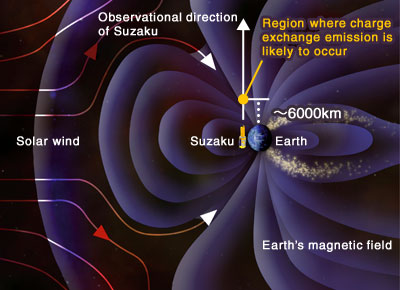TOP > Report & Column > The Forefront of Space Science > 2007 > The Origin of Mysterious X-ray Emission was Solar Wind !
![]()

Now that the energy of each emission line is determined, we can identify which emission line corresponds to which ion and which transition. As a result of our investigation, we found that the emission lines which appeared at the enhancement could be explained by emission lines of highly ionized carbon, oxygen, neon, magnesium and iron. Now, please look at the emission line at an energy level of around 460 electron volt (wavelength 2.7 nanometer) indicated by the red arrow in Fig. 4. This emission line corresponds to an electron transition from the 4th orbit to the innermost orbit of a carbon ion with only one electron (see Fig.1). This emerges only when a fully ionized carbon ion collides with neutral matter to cause a charge exchange interaction, and will never be prominent if it comes from hot gases of several millions Kelvin. Thus, Suzaku’s observational result clearly indicates that the mysterious X-ray enhancement is caused by charge exchange interaction. Previously, there has never been any data that showed this emission line as clearly as that obtained by Suzaku. Where does the charge exchange emission take place? Now, where does the charge exchange emission take place? As a result of our close examination of the temporal variation in the X-ray light-curve at the enhancement shown in Fig. 2 and the line-of-sight direction of Suzaku, we noticed a trend that X-rays became strongest when Suzaku’s line of sight lowered to an altitude of 6,000 km above the magnetic pole. And we suggest that solar wind reached the altitude as low as about 6,000 km and charge exchange interaction occurred there with neutral atoms, which then emitted X-rays (Fig. 5). On Jupiter, an X-ray emission phenomenon called the X-ray aurora is observed. Observational results from Suzaku suggest that a similar event occurs on earth. Of course, this result is a world first. 
Conclusion and expectations for Suzaku The mysterious X-ray enhancement occurred during observation of X-ray background radiation in the northern ecliptic polar region by Suzaku. We successfully retrieved good X-ray spectra by making use of Suzaku’s capability and discovered that the mysterious X-ray enhancement could be explained only by emission lines from ionized ions. Moreover, we obtained an emission line peculiar to a charge exchange interaction more clearly than ever before and unraveled that the origin of the mysterious X-ray enhancement was charge exchange interaction with solar-wind ions. Suzaku’s observational results also suggest that solar wind enters about an altitude 6,000 km on the ground and causes a charge exchange emission there. Soft X-rays are emitted around comets because of the charge exchange interaction of solar wind. In addition, it is suggested that the whole solar system also emits soft X-rays by the same mechanism. The emission provides us with an important clue for observational research on outer layers of atmosphere around the earth and planets, low-density neutral matter around comets, the ion composition of solar wind, etc. On the other hand, the emission becomes a very troublesome obstacle when we observe soft X-rays from hot interstellar matter in supernova remnants and/or inside and outside our Galaxy. This is because X-rays from hot interstellar matter and from charge exchange interaction are similar both spatially and spectrally, making it difficult to distinguish one from another. Suzaku has an unprecedented capability for soft X-ray observations, so we believe that it can contribute greatly to advancement in this old, and yet new research fields. We anticipate great contributions from Suzaku in the future. (Ryuichi FUJIMOTO) Reference literature:
|
||||||||




